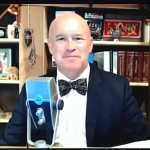Uploaded by ScienceAtNASA
Jun 9, 2011
NASA’s Voyager probes have reached the edge of the Solar System and found something surprising there–a froth of magnetic bubbles separating us from the rest of the Galaxy.
===
by Alton Parrish
June 9, 2011
Observations from NASA’s Voyager spacecraft, humanity’s farthest deep space sentinels, suggest the edge of our solar system may not be smooth, but filled with a turbulent sea of magnetic bubbles.
While using a new computer model to analyze Voyager data, scientists found the sun’s distant magnetic field is made up of bubbles approximately 100 million miles wide. The bubbles are created when magnetic field lines reorganize. The new model suggests the field lines are broken up into self-contained structures disconnected from the solar magnetic field. The findings are described in the June 9 edition of the Astrophysical Journal.
Like Earth, our Sun has a magnetic field with a North Pole and a South Pole. The field lines are stretched outward by the Solar Wind or a stream of charged particles emanating from the star that interacts with material expelled from others in our corner of the Milky Way Galaxy.
The Voyager spacecraft, more than nine billion miles away from Earth, are traveling in a boundary region. In that area, the solar wind and magnetic field are affected by material expelled from other stars in our corner of the Milky Way Galaxy.
“The sun’s magnetic field extends all the way to the edge of the solar system,” said astronomer Merav Opher of Boston University. “Because the sun spins, its magnetic field becomes twisted and wrinkled, a bit like a ballerina’s skirt. Far, far away from the sun, where the Voyagers are, the folds of the skirt bunch up.”
Understanding the structure of the sun’s magnetic field will allow scientists to explain how galactic cosmic rays enter our Solar System and help define how the star interacts with the rest of the Galaxy.
Using a computer model based on Voyager data, scientists have shown that the Sun’s magnetic field becomes bubbly in the Heliosheath due to reconnection.
NASA’s Voyager probes are truly going where no one has gone before. Gliding silently toward the stars, 9 billion miles from Earth, they are beaming back news from the most distant, unexplored reaches of the Solar System.
Mission scientists say the probes have just sent back some very big news, indeed.
It’s bubbly out there.
Magnetic bubbles at the edge of the Solar System are about 100 million miles wide–similar to the distance between Earth and the Sun.
According to computer models, the bubbles are large, about 100 million miles wide, so it would take the speedy probes weeks to cross just one of them. Voyager 1 entered the “foam-zone” around 2007, and Voyager 2 followed about a year later. At first, researchers didn’t understand what the Voyagers were sensing–but now they have a good idea.
“The Sun’s magnetic field extends all the way to the edge of the solar system,” explains Opher. “Because the sun spins, its magnetic field becomes twisted and wrinkled, a bit like a ballerina’s skirt. Far, far away from the sun, where the Voyagers are now, the folds of the skirt bunch up.”
When a magnetic field gets severely folded like this, interesting things can happen. Lines of magnetic force criss-cross, and “reconnect”. (Magnetic reconnection is the same energetic process underlying solar flares.) The crowded folds of the skirt reorganize themselves, sometimes explosively, into foamy magnetic bubbles.
“We never expected to find such a foam at the edge of the Solar System, but there it is!” says Opher’s colleague, University of Maryland physicist Jim Drake.
Theories dating back to the 1950s had predicted a very different scenario: The distant magnetic field of the sun was supposed to curve around in relatively graceful arcs, eventually folding back to rejoin the sun. The actual bubbles appear to be self-contained and substantially disconnected from the broader solar magnetic field.
Energetic particle sensor readings suggest that the Voyagers are occasionally dipping in and out of the foam—so there might be regions where the old ideas still hold. But there is no question that old models alone cannot explain what the Voyagers have found.
Says Drake: “We are still trying to wrap our minds around the implications of these findings.”
The structure of the sun’s distant magnetic field—foam vs. no-foam—is of acute scientific importance because it defines how we interact with the rest of the galaxy. Researchers call the region where the Voyagers are now “the heliosheath.” It is essentially the border crossing between the Solar System and the rest of the Milky Way. Lots of things try to get across—interstellar clouds, knots of galactic magnetism, cosmic rays and so on.
Will these intruders encounter a riot of bubbly magnetism (the new view) or graceful lines of magnetic force leading back to the sun (the old view)?
Old and new views of the heliosheath. Red and blue spirals are the gracefully curving magnetic field lines of orthodox models. New data from Voyager add a magnetic froth (inset) to the mix.
The case of cosmic rays is illustrative. Galactic cosmic rays are subatomic particles accelerated to near-light speed by distant black holes and supernova explosions. When these microscopic cannonballs try to enter the solar system, they have to fight through the Sun’s magnetic field to reach the inner planets.
“The magnetic bubbles appear to be our first line of defense against cosmic rays,” points out Opher. “We haven’t figured out yet if this is a good thing or not.”
On one hand, the bubbles would seem to be a very porous shield, allowing many cosmic rays through the gaps. On the other hand, cosmic rays could get trapped inside the bubbles, which would make the froth a very good shield indeed.
So far, much of the evidence for the bubbles comes from the Voyager energetic particle and flow measurements. Proof can also be obtained from the Voyager magnetic field observations and some of this data is also very suggestive. However, because the magnetic field is so weak, the data takes much longer to analyze with the appropriate care. Thus, unraveling the magnetic signatures of bubbles in the Voyager data is ongoing.
“We’ll probably discover which is correct as the Voyagers proceed deeper into the froth and learn more about its organization,” says Opher. “This is just the beginning, and I predict more surprises ahead.”
So far, much of the evidence for the existence of the bubbles originates from an instrument aboard the spacecraft that measures energetic particles. Investigators are studying more information and hoping to find signatures of the bubbles in the Voyager magnetic field data.
“We are still trying to wrap our minds around the implications of the findings,” said University of Maryland physicist Jim Drake, one of Opher’s colleagues.
Launched in 1977, the Voyager twin spacecraft have been on a 33-year journey. They are en route to reach the edge of interstellar space. NASA’s Jet Propulsion Laboratory in Pasadena, Calif., built the spacecraft and continues to operate them. The Voyager missions are a part of the Heliophysics System Observatory, sponsored by the Heliophysics Division of NASA’s Science Mission Directorate in Washington.
Contacts and sources:
Dr. Tony Phillips, NASA’s Goddard Space Flight Center
Dwayne C. Brown ,Headquarters, Washington









Add comment